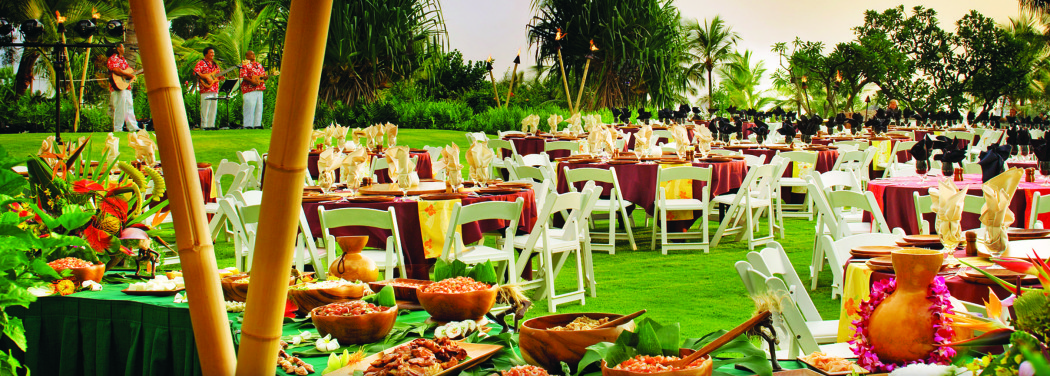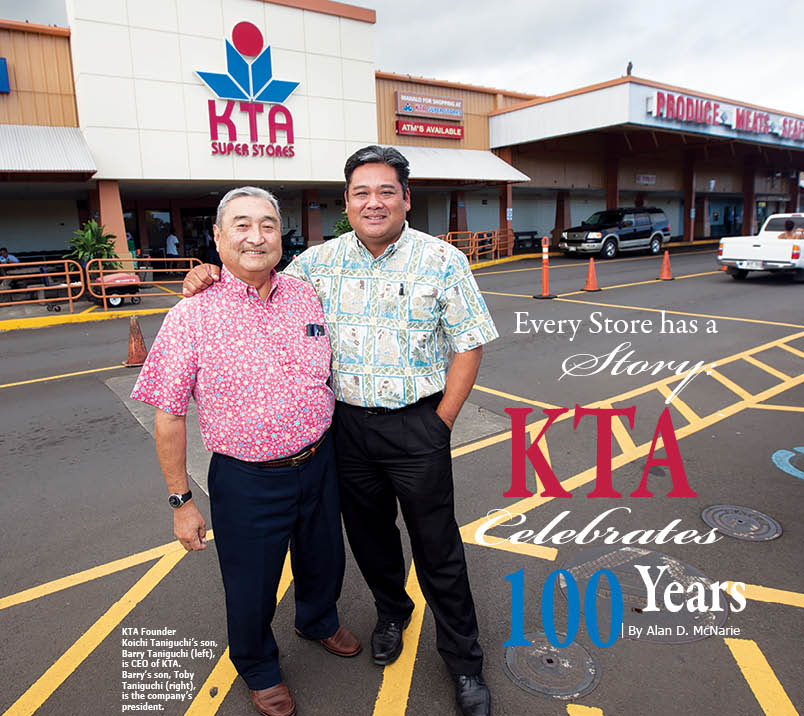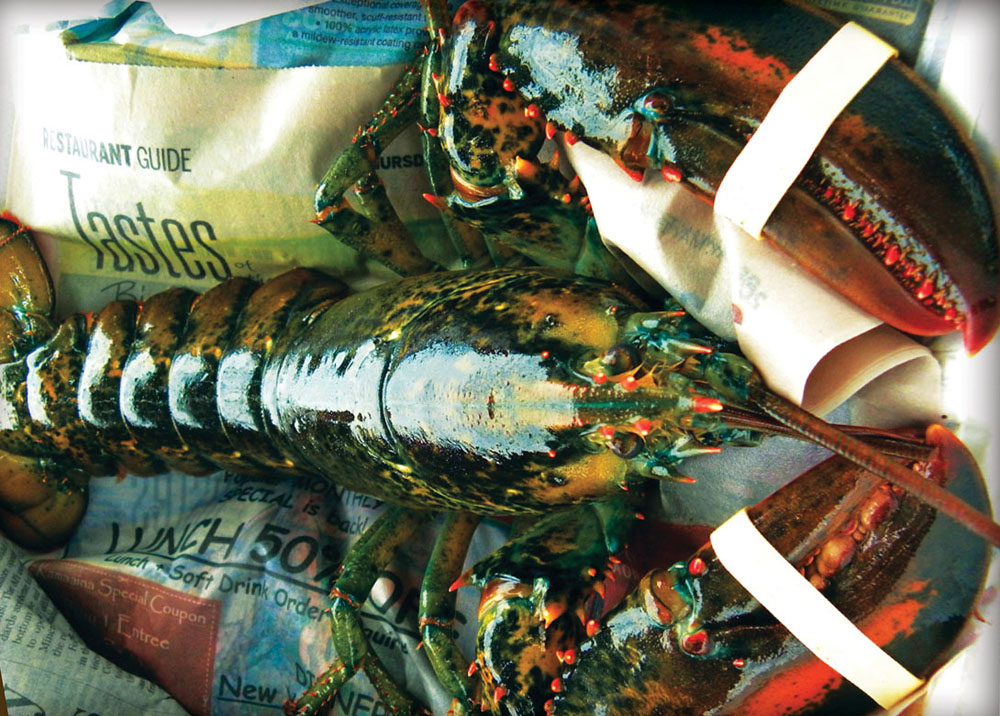
Behind the Scenes at the Lu‘au: History and ‘Ohana Craft a Memorable Experience
 By Marya Mann
By Marya Mann
The emcee’s voice sets the tone of enchantment for visitors to Hawai‘i, first through a culinary feast and into the dreamscape of a Pacific odyssey. They’ve been anticipating this evening for a long time, a climax to a dream vacation or honeymoon—a real Hawaiian lū‘au, a Polynesian immersion experience.
On a green expanse of lawn overlooking the dusky blue sea, brightened by a lingering sun, the evening begins.
The conch shell is blown, marking the official beginning of this particular lū’au’s new show, “Hāleo,” the Voice of Life. A raised earthen platform and lava-like sets with honu and paddler petroglyphs await the evening’s performance.
Warming up the guests, a sumptuous buffet, displayed on monkeypod wood platters bedecked with hibiscus flowers and ti leaf greenery, serves up kālua pork fresh from the imu, ‘ulu, poi, ‘uala (Hawaiian sweet potato), island fish, chicken lū‘au, tropical fruits, pastries and mai tais.
In the wings, the cast of dancers, musicians, directors and technical staff come together in a pule, or prayer circle. Laughing, they tease each other to move out the spotlight “into the dark” if they forget their place, which is unlikely in this professional ensemble of ten dancers, five musicians, an emcee and a Samoan fire-knife dancer. Holding hands, they affirm their promise to embody the legends and history of Pacific Rim cultures through mele (song), dance, comedy, theater, education and the spirit of lōkahi, or unity.
“Every major event in Hawai‘i begins with a pule, or prayer,” says Kumu Hula Paoakalani Patu, director of productions for Island Breeze Productions, which produces this lū‘au at the Sheraton Keauhou Bay Resort and Spa, as well as customized productions at two other hotels on the island, Courtyard by Marriott King Kamehameha’s Kona Beach Hotel and Fairmont Orchid. Her full-bodied passion for dance ignites a fiery light in her liquid brown eyes, her serene face and easy smile emphasizing every word.
“When everyone comes together and joins hands as family,” she says, squeezing invisible hands to illustrate, “we are unified and on the same page in hearts and minds.”
“Talofa! Join the ‘aiga (family) in Samoa where the people love life and enjoy having a great time. You will be fascinated by the bravery and courage of the Siva ‘Afi (Samoan fire-knife dance).”
The journey to this evening’s high-energy performance began more than 25 years ago, in the 1990s, when several Hawai‘i Island families came together with the idea of creating a professional lū‘au experience that reflected the essence of Hawaiian and Polynesian life.
They wanted to produce an artistic, culinary and educational, cultural extravaganza that would “raise up” Hawaiians and Pacific Islanders, empower and dignify young artists with training, opportunities and mentorships in good professions, and offer jobs and income to support their dreams.
With a current staff of 75 full-time and part-time workers performing regularly three nights a week, the company, Island Breeze, is an extended family, an ‘ohana made up of parents, aunties, uncles and children, all sharing the values of “living aloha, embracing ‘ohana and creating memories that last forever.”
The Creative Process
From concept to theme, research and writing, the early stages of producing a new show like “Hāleo” begins with collaboration. “What’s really beautiful about this team effort is that it’s one of the core things that matter to us in our South Pacific cultures, and in Hawai‘i. That (team effort) is what we express through our production,” says Becky Fernandez, director of marketing.
Sometimes the theme is place-oriented, as at Keauhou, or culture-specific, as when corporations like Mitsubishi request motivational theatrical events, lū‘au and performances for their specific needs. With the goal of helping guests to sense the mana, or power, in the Polynesian cultural heritage, they render such historical subjects as the birth of King Kamehameha III, a central figure in “Hāleo,” with dramatic flourish.
“Once the management team has settled on a theme, it gets handed over to each department,” says Paoakalani, gesturing with her hands—hula dancer’s hands that began their storytelling motions while watching classes at her mother’s Hilo hula studio more than 40 years ago. Paoakalani danced on stage with Island Breeze until 1998. As she matured, her creative fervor shifted and she began choreographing.
“I put together the choreography and how it’s all going to come together, but our cultural advisor Leina’ala [Fruean] brings in her mana’o [wisdom]. She opens up the door, and I take and just expand on it with my creativity, try to bring that to life. Becky [Fernandez] and Taimane [Kaopua] as well, in their knowledge, help to look at how we express the essence of the theme.”
One of four emcees working with Island Breeze, Kealoha wrote the script for “Hāleo,” and, along with Paoakalani’s choreography and musical arrangements by the musicians, the artistic quality comes through the respectful attitude of collaboration weaving through the creative process. Next, set designs, costumes, lighting and stage configurations evolve, creating the whole theatrical and educational impressions relating back to the theme.
Legacy of Light: Kamehameha III
Under a violet sky threaded with stars, Jupiter and a milky crescent moon, surrounded by ‘ohana on a Monday night, the company is performing in front of a “small audience” of 200 people. “The Voice” comes to life: “Now welcome to Keauhou, a place of history and Hawaiian treasures,” emcee Taito Collins intones into the microphone. A boisterous mix of Don Ho and your favorite uncle, he draws you in. “Keauhou means new beginnings, or new era. Not too far from where we’re sitting, Kauikeaouli was born.” You think you hear “Kow ee kay ah oh oolee,” but it goes by fast.
Kamehameha III, who was stillborn in1813, but revived by a kahuna, went on to become a great leader. With ever-increasing pressure from foreign conflicts and the arrival of diseases that decimated Native Hawaiians, he believed that education was the key to the survival of his people. By the end of his 30-year reign, Hawai‘i was one of the most literate nations in the world, the audience learns.
People who come to the lū‘au are also revived. You can see it in satisfied faces relaxing under the firelight—and it’s not just the mai tais—they are revived by what they see, hear and feel.
The language of the body expressed in “Na Hiku,” for instance, is a message from the heavens in hula. The theme of the dance, the seven elements sustaining the beauty of hāleo in your life—discipline, strength, endurance, knowledge, understanding, wisdom and authority—introduces the theme of the evening.
You feel the vitality of “Te Maunga,” the dance of New Zealand warriors bracing their legs in determination and understanding that “their language is the window to their soul.”
The mana continues in dances and songs from Fiji, Tahiti and Samoa. You sense a meeting with kin among the performers, recreating the dances of their Polynesian cousins across the wide Pacific. Behind the scenes, elders in the wings, too careful to call themselves kahuna, give “spiritual coverage” for everyone to become a part of the sense of community, excellence and family in the tender tropical light.
As the music weaves together cultures from throughout the Pacific Ocean, you let your whole body enjoy the tempo of the drums, the strumming of strings, the harmony of voices of Pacific islanders who embody one Oceanic call: “We are family!”
“Meet our cousins, the first families to the Hawaiian Islands, the ‘Tahitians.’ After the islands were settled, they arrived in double-hulled canoes from the south. Come and listen to their resounding drums and pounding rhythms and the dance,La Orana!”
Tahitian dance is all about the rapid movement of hips. The hula is more fluid, with a focus on the hands. Each South Pacific culture offers its unique Polynesian gift to the world. “Each culture has a gift that the others need too,” says Becky. “Hawai‘i’s gift is aloha.” People come to the islands looking for peace and for a sense of belonging.
“In Samoa, it’s their strength in hospitality that’s amazing,” adds Paoakalani. “Each island—and we’ve been to them, studied them—each island has that pearl of authentic beauty we try to capture in our dance and music, in a form that all age groups can identify with.”
Director of Marketing Becky Fernandez’ husband, Tom, is one of the fire-knife dancers; and her daughter, at the age of four, called Kumu Paoakalani to ask if she could start dancing with the hālau. “That’s quite a challenge, I told her,” says Becky.
“What an investment, working toward becoming a dancer.”
“It’s not like one shift and you’re trained,” says Kumu Paoakalani. “It takes months and years.”
Becky’s daughter is now 14 and works as a lei greeter for the company. She has been studying hula for a decade and is being steeped in the practices and ethics that will prepare her as an Island Breeze performer.
“It’s a family affair,” says Paoakalani. “It’s a job, but it’s more than that: it’s life and relationships with one another, being part of each others’ lives. It’s really like ancient hālau days. Dancers and kumu lived with each other, eating and sleeping in the same big hale, but we don’t do that. We live in different homes, but when we get together, it’s family. And when there are issues, we walk them through.”
“Kia’ora! Native to New Zealand are the Maori. You are welcomed into their whanau [family] and greeted with a haka by our Maori warriors. Women complement the strength of the men with their powerful ‘Karaga’ [chant] and the graceful ‘waiata a ring’ long poi ball dance.”
So You Want to Dance
The company auditions and hires skilled, committed performers and welcomes applicants from all races and cultures, yet at least half of the company is presently related by blood or marriage. Luki Wooching, for instance, a Samoan dancer, the crafty “coconut” comedian, has performed onstage with his Samoan daughter while his wife, a modern dancer and seamstress from Washington State, works at the lū’au reservations desk and as a costume designer, seamstress and modern dancer. Wives, husbands, uncles and sisters help mount shows at the Fairmont Orchid and Courtyard by Marriott King Kamehameha’s Kona Beach Hotel, as well as at the Sheraton; they fill in as dancers, reservationists and reviewers, and bounce around ideas as needed.
“Our children very much have a voice with us,” says Paoakalani. “People come to the lū’au and see that they have a voice. The show itself is about voice.” Giving voice to the next generation, while a significant goal, also poses her biggest challenge: finding good people to work with. “We want people who have both the skill in dancing or music, and who are also willing to do what it takes to do it. Times have changed.”
Describing the younger generation, she says, “I’m not labeling everyone, but you definitely see the difference in work ethics and commitment from those who have been in the industry a long time and the standards they hold. Although we are a family, there is a standard of how you present yourself.”
It’s all part of life in the business of show business that precedes and goes on long after the show is over.
“Bula Vinaka! Anthropologists believe the people of Fiji eventually settled all of Polynesian. Their ‘meke,’ or spear dance fascinates audiences because of the dancers’ agility.”
A New Era
But is it a real lū‘au? Here, at a hotel, surrounded by 200 neophytes who may have discovered that in pre-contact Hawai‘i, eating was an act of worship, cooking a sacrifice to transform mana, and farming and fishing conscious acts of religious devotion. Smelling the evening fragrance, looking past the hibiscus exuberance to the real lū‘au, not just the “tourist version,” but an honorable feast at Keauhou, “the place of new beginnings,” the birthplace of a king, a battleground over ancient tradition, and the start of a new era.
“We each play such a significant role in how we unfold the evening for our guests,” says Paoakalani, but it’s not just joining hands, joining as family, and saying “Let’s do this together.” Work on a new show begins months, years, many generations before you roam, frosted glass and pineapple wedge in hand, among the hala trees, sampling seven different kinds of vegetables and Kona Coffee chocolate cake.
The lū‘au is more than the sum of its succulent salads and genuflecting, glimmering, heart-felt dances. You came, you enjoyed, you drank well, you felt the mana and you learned something, too. A lū‘au opens your heart to the Polynesian and Hawaiian culture. You’re no longer guests. You’re family. ❖
Contact writer Marya Mann: marya@loomoflove.com
Website: islandbreezeluau.com


